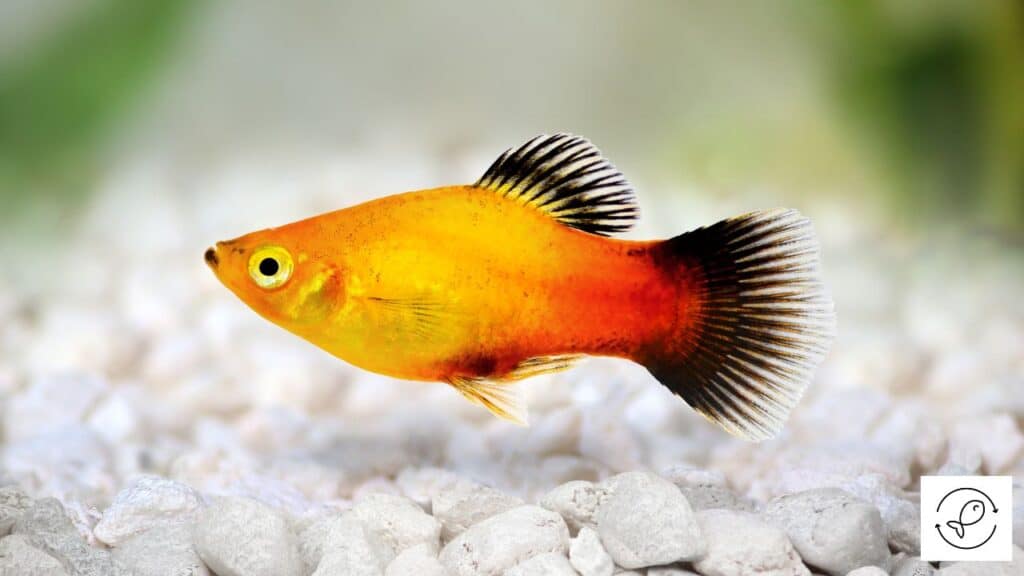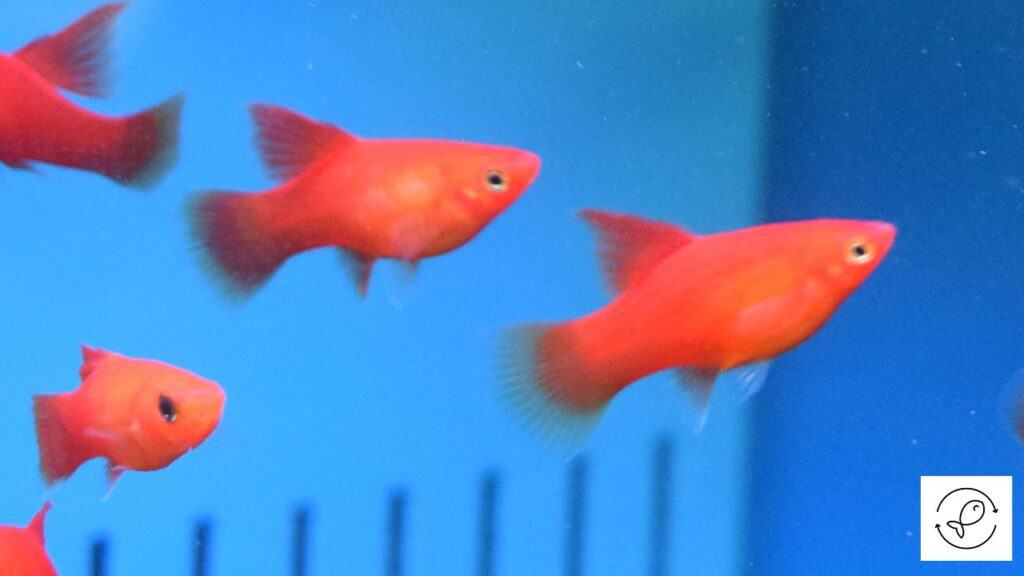Platies grow around 2.5 inches in length. Female platies grow larger than males. Dwarf platies are selectively bred for shorter body lengths. They usually stay around 1 inch. A nutritious diet, adequate space, optimal water parameters, and a stress-free environment are vital for their optimum growth.
Let’s now understand how to grow platies faster and bigger in more detail.
Ways to Increase the Size of Platies
The growth of platies depends on the care and environment that they are provided.
Platies thrive when kept in favorable living conditions.
Adequate care and nutrition during the early stages of their life are imperative for their development.
Given below are some tips to increase the size of your platies.
Get an appropriate-size tank.
Platies are small fish that don’t grow as big as some of the other freshwater fish.
Their small size can deceive you into thinking that they don’t need a large tank.
However, platies need an appropriately-sized tank as they like to swim freely and explore the environment.
Besides, they are highly active and thrive in groups.
Hence, a tank of a minimum of 10 gallons or more is recommended for a group of platies.
A large tank will ensure that the platies have enough space to swim and grow to their full size.
Feed a nutritious diet.
A healthy and nutritious diet is essential for the growth of platies.
They need a balanced diet that includes proteins, vitamins, minerals, and other nutrients.
You can feed them high-quality flakes or pellets designed explicitly for their growth.
You can also supplement their diet with live or frozen food to meet their protein requirement.
Platies are known for their enormous appetite. So you need to feed them thrice a day.
Feed them only the amount of food that they can eat in about 3 minutes.
Feeding a balanced diet enhances their coloration, strengthens their immunity, and leads to rapid growth.
Maintain an ideal male-to-female ratio.
Maintaining an ideal male-to-female ratio is vital for the health and growth of platies.
Platies are social fish, and they thrive in groups.
A group of platies should have one male and three female platies; that’s a ratio of 1:3.
This will help reduce aggression between male platies and ensure that too many males don’t overstress the females.
Maintaining an ideal male-to-female ratio also helps promote healthy growth and development of the platies since they stay happy and stress-free.
If there are too many male platies with fewer females, it can lead to aggression. This can adversely impact their health and growth.
Perform regular tank maintenance.
Regular tank maintenance is essential for the health and growth of platies.
It helps to keep the water clean and free from toxins, which in turn promotes healthy growth.
Tank maintenance should include regular water changes, cleaning the substrate, and removal of any debris and uneaten food.
Conducting partial water changes of 15 to 20% every two weeks helps to remove contaminants from the aquarium.
The installation of a filter is also best to maintain water quality.
The water temperature should be monitored regularly to ensure that it remains within the ideal range for platies.
Maintain optimum water parameters.
Water parameters play a significant role in promoting the growth of platies.
Platies thrive in water temperatures ranging between 65°F to 77°F (18°C to 25°C) and pH levels between 7 to 8.
Monitoring the water parameters regularly ensures that they remain within the ideal range.
Any sudden or drastic fluctuations in water parameters can adversely impact the growth of platies.
Provide a stress-free environment.
Platies need a stress-free environment to grow and thrive.
A stressful environment can lead to stunted growth, poor coloration, and health issues.
Creating a healthy living environment reduces stress and encourages growth.
You can provide a stress-free environment for platies by providing plenty of hiding spots, adequate space for swimming, compatible tankmates, adequate lighting, and avoiding overcrowding.
Factors that Hinder the Growth of Platies

Platies don’t grow too big. However, they need favorable living conditions for optimum growth.
Many aquarists complain about the slow growth rate of their fish.
Given below are the numerous factors that can hinder the growth of platies.
Overcrowding
Overcrowding is one of the significant factors for platies’ slow growth.
When the tank is overcrowded, it can cause stress and competition for food.
This can adversely affect the growth of platies.
Moreover, an overcrowded tank can also lead to poor water quality, space shortage, and less dissolved oxygen.
All these factors can stress the platies, resulting in slow growth.
Poor Water Quality
Poor water quality can also majorly affect platies’ growth.
Platies need pristine water conditions to thrive. They will struggle to grow in the absence of good water quality.
Excessive ammonia levels caused by bad water quality can lead to illness and decrease the overall strength of your platies.
It will ultimately lead to stress, which can make the platies sick and stunt their growth.
Poor and Insufficient Diet
Platies need adequate nutrition for optimal growth.
An inadequate diet can lead to nutrient deficiencies and hinder platies’ ability to metabolize other nutrients properly.
Minerals and vitamin deficiencies can result in stunted growth and other health issues for platies.
Moreover, poor nutrition can weaken platies’ immune systems and make them susceptible to diseases.
Insufficient food will also weaken them, affecting their growth.
Inadequate Tank Size
Platies need ample space to swim and explore their surroundings.
If the tank is too small, they will not be able to reach their full size.
Besides, small tanks are more prone to water quality issues, which can also stunt the growth of the fish.
Housing platies in a small aquarium can lead to unnecessary stress.
This will weaken their immune system, impacting their health and development.
Stressful Environment
Stress is one of the main factors that can prevent platies from reaching their full size.
Stress can be caused by various things, such as overcrowding, poor water quality, inadequate diet, incompatible tankmates, unfavorable water parameters, lack of hiding places, or sudden environmental changes.
Platies are sensitive to stress, and it can harm their growth.
When platies are stressed, they become less active and may stop eating altogether.
It can lead to a decline in growth and even make them ill.
How Long Does It Take for Platies to Grow?
Platies take around 5 to 6 months to reach their full size in captivity.
However, this can vary depending on their living conditions and diet.
They grow faster in their natural habitat due to the abundance of food and ideal water conditions.
The growth of platies largely depends on the diet, water quality, and the size of the tank.
Platy fry are born extremely small, measuring approximately 0.25 inches.
At the end of their fry stage, roughly a month after hatching, they can grow up to two times their size or even larger sometimes.
Female platies are usually larger, reaching up to 2.5 inches in length as adults.
On the other hand, male platies usually grow up to a maximum of 2 inches in length.
Some platies show coloration right after birth, while others may take a month.
Platy fry usually display their vibrant colors when they are two to three months old.

